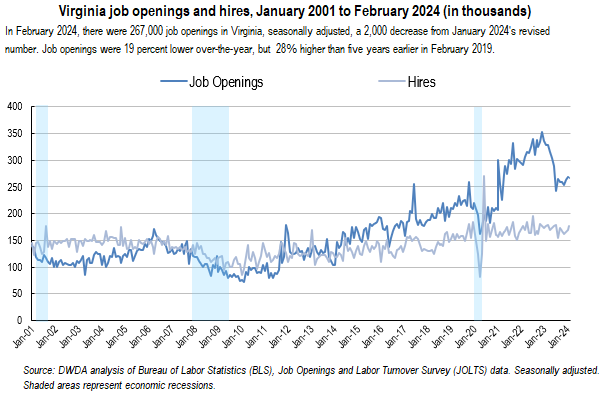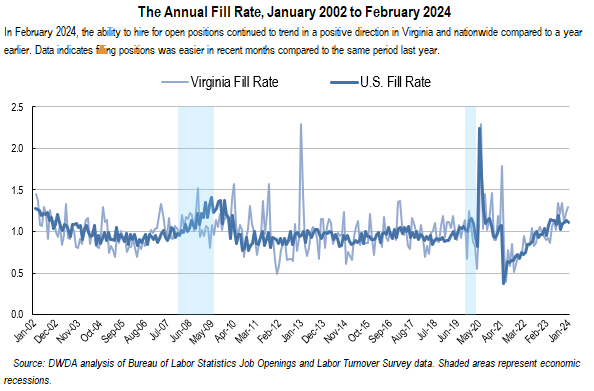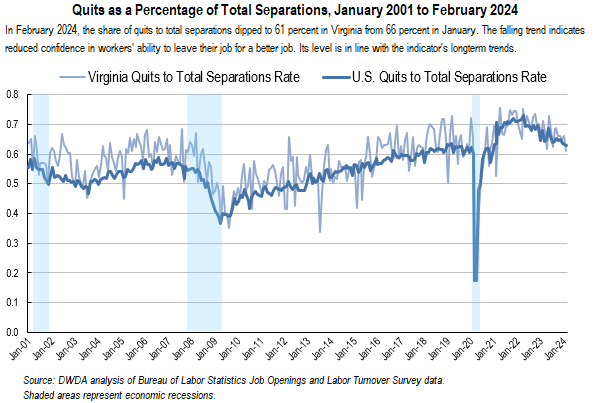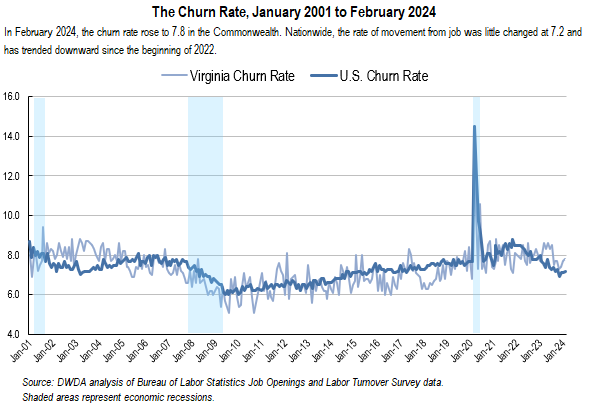April 19, 2024
RICHMOND— Virginia Works (the Virginia Department of Workforce Development and Advancement) announced today that the U.S. Bureau of Labor Statistics’ February 2024 Job Openings and Labor Turnover Survey (JOLTS) reports job openings continue to remain at elevated levels.
According to the most recent BLS JOLTS survey data, the number of February 2024 job openings in Virginia was little changed over the month, but up by 28 percent from five years earlier. BLS JOLTS data provides information on all the pieces that go into the net change in the number of jobs. These components include job openings, hires, layoffs, voluntary quits, and other job separations (which includes retirements and worker deaths). Putting those components together reveals the overall change in payroll employment. JOLTS data is seasonally adjusted and describes conditions on the last business day of the month. Current month’s data are preliminary and the previous month’s data have been revised.
On the last business day in February, there were 267,000 job openings in Virginia, seasonally adjusted, a 2,000 decrease from January’s revised figure. The number of U.S. job openings changed little at 8.8 million; this measure is down from a series high of 12.2 million in March 2022. U.S. job openings significantly increased in finance and insurance (+126,000); state and local government, excluding education (+91,000); and arts, entertainment, and recreation (+51,000). Job openings decreased in information (-85,000) and in federal government (-21,000). The largest decreases in the job openings level occurred in Oregon (-28,000), Ohio (-24,000), and Maryland (-18,000). The largest increases occurred in Arizona (+37,000), Indiana (+18,000), and Hawaii (+6,000).

In Virginia, the February job openings rate was 6.0 percent, unchanged from January. The U.S. job openings rate was unchanged at 5.3 percent for the third month in row. The largest decreases in job openings rates occurred in Oregon (-1.2 percentage points) and in the District of Columbia and West Virginia (-1.0 point each). The increases occurred in Arizona (+1.0 point) and in Hawaii and Rhode Island (+0.9 point each).
The number of hires in Virginia increased to 177,000 in February, an increase of 8,000 over the month and was unchanged from February 2023. JOLTS defines hires as all additions to the payroll during the month. The number of hires was 35 percent lower than the series high of 271,000 set in June 2020. Nationwide in February, the number of hires was little changed at 5.8 million. Hires significantly decreased in durable goods manufacturing (-44,000). The largest increases in the hires level occurred in Florida (+56,000), Tennessee (+35,000), and Ohio (+32,000). The decreases occurred in New York (-34,000), Pennsylvania (-31,000), and South Carolina (-16,000). In Virginia, the 4.2 hires rate edged up from January’s revised 4.0 percent rate. The U.S. hires rate was little changed at 3.7 percent. Significant increases in the hires rate occurred in Tennessee (+1.0 percentage point) and Maine (+0.9 point), as well as in Florida, Missouri, and Ohio (+0.6 point each). The decreases occurred in South Carolina (-0.7 point) and Pennsylvania (-0.5 point).

The Virginia hires-per-job-openings (HPJO) ratio was little changed at .66 percent. This was the same as nationwide, where it has hovered around two hires per three openings over the past year. This measure shows the rate of hiring compared to open jobs and is a proxy for time to fill positions.
In February 2024, the Virginia ‘annual fill’ rate (the ratio of ‘this month’ hires to ’last month’ job openings, over the year) remained significantly above the historical, typical level of 1.0 at 1.25. The fill rate is a measure used to evaluate how labor markets differ in the pace that job openings are filled. An annual fill rate near or above 1.0 can indicate that employers are growing more efficient at filling job openings. On the other hand, an annual fill rate of less than 1.0 can indicate a tighter labor market, with employers having greater difficulty filling job openings compared to a year earlier. Going back to 2001, the highest annual fill rate occurred during June 2020 because, after the nationwide shutdown due to the COVID-19 pandemic, employers across the country sought to quickly hire for vacated positions. The lowest fill rate in Virginia occurred in June 2021. During that time, there were many factors that hindered the filling of vacant positions by employers, such as health concerns, employee skills, and childcare needs, but the biggest factor was the comparison against the historic re-hiring hike the year before.
Total separations in Virginia decreased by 3,000 to 152,000. Nationwide, the number of total separations changed little at 5.6 million. Over the month, the number of total separations nationwide significantly increased in arts, entertainment, and recreation (+64,000) but decreased in transportation, warehousing, and utilities (-62,000). The largest increases in the total separations level occurred in Minnesota (+40,000), Tennessee (+27,000), and Ohio (+26,000). The decreases occurred in New Jersey (-25,000), Kansas (-9,000), and Nebraska (-8,000). The Virginia total separations rate decreased from 3.7 to 3.6 percent. The U.S. total separations rate was unchanged at 3.5 percent. The largest increases in total separations rates occurred in Minnesota (+1.3 percentage points), Maine (+1.0 point), and Alaska (+0.9 point). The decreases occurred in Nebraska (-0.8 point) and New Jersey (-0.6 point).

An estimated 92,000 workers quit jobs from Virginia employers in February. The number of quits decreased by 10,000 from January’s revised figure of 102,000. That was a 16 percent decrease over-the-year and a four percent decrease from five years earlier. Quits, a component of total separations, are voluntary separations initiated by the employee. Nationwide, the number of quits was little changed at 3.5 million. The largest increases in the quits level occurred in Florida (+35,000), Missouri (+25,000), and Nevada (+10,000). The decreases occurred in Colorado (-13,000) and West Virginia (-4,000). The quits rate in the Commonwealth edged down to 2.2 percent and remained at levels seen over the last two years. Over the month, the U.S. rate was little changed at 2.2 percent for the fourth consecutive month. The increases in quits rates occurred in Missouri (+0.8 percentage point), Nevada (+0.7 point), and Florida (+0.4 point). The decrease occurred in West Virginia (-0.6 point).
The number of layoffs and discharges in Virginia rose to 47,000 in February. This was up over 42 percent over the year, and 28 percent up from five years earlier. Layoffs and discharges are countercyclical, which means that layoffs typically increase during economic contractions and decrease during economic expansions. In February, the number of U.S. layoffs and discharges changed little at 1.7 million. The number of layoffs and discharges significantly increased in accommodation and food services (+67,000) and in arts, entertainment, and recreation (+57,000). The Virginia layoffs and discharges rate remained to one percent, while the U.S. rate was little changed at 1.1 percent.

The February ‘churn rate’ (sum of the hires rate and total separations rate) in Virginia and nationwide edged up, but recent trends indicated a continued deceleration of movement of workers from job to job since the beginning of 2022. While more volatile month-to-month, Virginia’s pace has been more resilient extending back to the pandemic year of 2020.
Information provided by the monthly JOLTS survey can show volitility from month to month, especially at the state level. And previous months’ data is revised. However, it often shows important trends in the labor market that can be difficult to obtain elsewhere. For example, the ratio of job quits to all job separations (a measure of job market and economic strength) fluctuates but it clearly shows that that percentage in Virginia and nationwide has trended downward since 2022. The good news in this case is that the monthly JOLTS survey also provides discrete measures of these indicators to compare current trends with previous, similar trends. While the Quits / Total Separations indicator trended downward in a manner like the 2007-09 ‘Great Recession,’ the current rate indicates that over six of every ten job separations has been a job quit, compared to a low of under four out of every ten during the Great Recession.
Definitions of JOLTS terms*
Job Openings
Job openings include all positions that are open on the last business day of the reference month. A job is open only if it meets the following three conditions: (1) A specific position exists and there is work available for that position; the position can be full time or part time, and it can be permanent, short term, or seasonal; (2) the job could start within 30 days, whether or not the employer can find a suitable candidate during that time; and (3) the employer is actively recruiting workers from outside the establishment to fill the position. Excluded are positions open only to internal transfers, promotions or demotions, or recalls from layoffs.
Hires
Hires include all additions to the payroll during the entire reference month, including newly hired and rehired employees; full-time and part-time employees; permanent, short-term, and seasonal employees; employees who were recalled to a job at the location following a layoff (formal suspension from pay status) lasting more than 7 days; on-call or intermittent employees who returned to work after having been formally separated; workers who were hired and separated during the month; and transfers from other locations. Excluded are transfers or promotions within the reporting location, employees returning from a strike, and employees of temporary help agencies, employee leasing companies, outside contractors, or consultants.
Separations
Separations include all separations from the payroll during the entire reference month and are reported by type of separation: quits, layoffs and discharges, and other separations. Quits include employees who left voluntarily, except for retirements or transfers to other locations. Layoffs and discharges include involuntary separations initiated by the employer, including layoffs with no intent to rehire; layoffs (formal suspensions from pay status) lasting or expected to last more than 7 days; discharges resulting from mergers, downsizing, or closings; firings or other discharges for cause; terminations of permanent or short-term employees; and terminations of seasonal employees (whether or not they are expected to return the next season). Other separations include retirements, transfers to other locations, separations due to employee disability, and deaths. Excluded are transfers within the same location, employees on strike, and employees of temporary help agencies, employee leasing companies, outside contractors, or consultants.
*Excerpted from U.S. Bureau of Labor Statistics, Handbook of Methods, Job Openings and Labor Turnover Survey: Concepts, https://www.bls.gov/opub/hom/jlt/concepts.htm.
Virginia Works plans to release the March 2024 analysis of the BLS Job Openings and Labor Turnover Survey for Virginia on Tuesday, May 21, 2024. The data for all states and the U.S. will be available on the BLS website JOLTS page, at https://www.bls.gov/jlt/. BLS is scheduled to release the March JOLTS data for states on Friday, May 17, 2024.
Technical note: January’s JOLTS analysis reflects revisions to U.S. figures that were made to the CES employment data in their annual benchmarking process. State revisions will be included in the May data release. The Bureau of Labor Statistics (BLS) Job Openings and Labor Turnover Survey (JOLTS) produces monthly data on U.S. and regional job openings, hires, quits, layoffs and discharges, and other separations from a sample of approximately 21,000 establishments. As a supplement, BLS has begun publishing state estimates that provide monthly information that can be used to better understand the dynamic activity of businesses in state economies that leads to aggregate employment changes. For more information on the program’s concepts and methodology, see “Job Openings and Labor Turnover Survey: Handbook of Methods” (Washington, DC: U.S. Bureau of Labor Statistics, July 13, 2020), https://www.bls.gov/opub/hom/jlt/home.htm. For more information on BLS’ state JOLTS estimates, see https://www.bls.gov/jlt/jlt_statedata.htm.
 PDF of Press Release
PDF of Press Release 